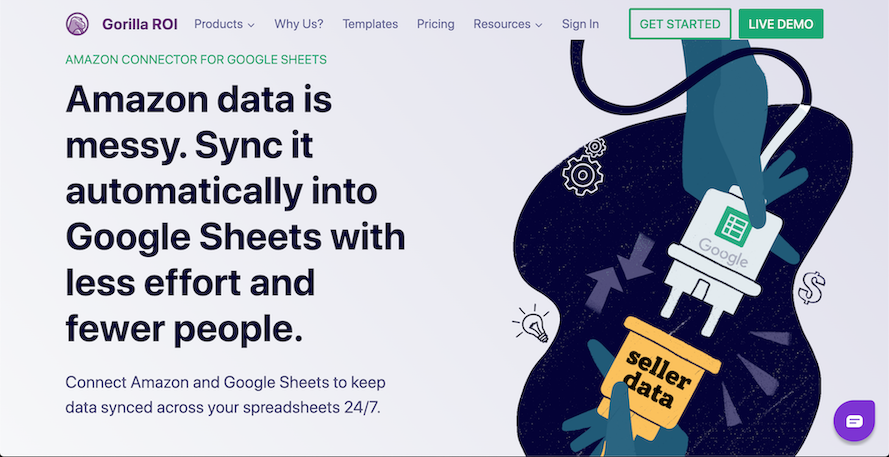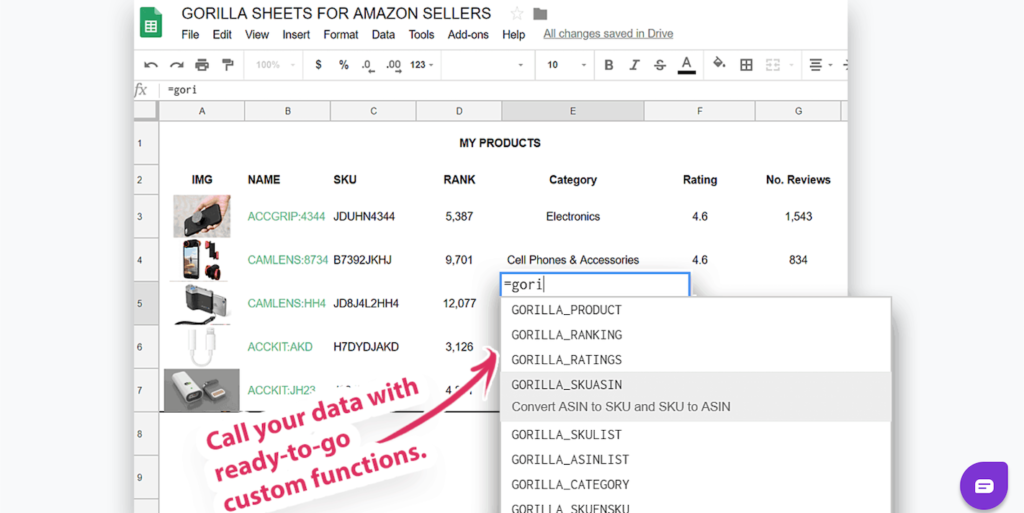
Who are you and what is your background?
I’m Jae Jun, my company A Time for Ventures, creates SaaS software focused on solving technical niche problems.
In the corporate world, I used to work as a QA and test engineer at Samsung, but corporate life didn’t suit me. I’m always curious and eager to learn, try and implement new things. Entrepreneurial characteristics that don’t fit well in a conglomerate.
In the business world, I had no educational background which meant I had a clean slate. I viewed it as an opportunity because it meant I could take everything with a fresh perspective and challenge existing ideas instead of just assuming that’s how it’s always done.
What is your business?
At the moment, we run Gorilla ROI, a SaaS for Amazon sellers to pull Amazon data into Google Sheets to help sellers outperform their competition by making it easy to access data, create unique custom reports, and improve efficiency with their data analytics.
We offer addon packages as well like an advanced spreadsheet template package, extra data addons the user can add on top of their base subscription.
Our focus is on the Amazon seller that generates over 7 figures of revenue, already use Google sheets extensively in their business, and data driven. Our niche is targeted, but because we niche down, we’ve been able to offer products and services that are needed but not served.
Before that, we created and sold Old School Value, a value investing focused stock analysis and valuation software which I started with spreadsheet templates and prototypes.

What was your professional situation right before starting the subscription site?
While I was creating Gorilla ROI, I was still running Old School Value. About 1 year into Gorilla ROI, I realized that the potential was much higher in this specific niche, and that’s when I started looking into selling Old School Value to focus on Gorilla ROI.
If I had to back up even further, I started Old School Value while I was still working my full-time job in the engineering industry. I’ve always had something to keep the cash flow going and to invest and grow the business without affecting personal finances until I saw that it was going to outgrow the current income source.
Ultimately I always want to focus on solving a very clear specific and existing problem. I don’t like to create a problem and then try to solve it which is what all the failed businesses have done.
I’ve always believed in hyper focusing on a single niche and a specific target customer. In the very beginning, I used myself as the target customer because I was out to solve a specific problem that I was facing. I knew that it wasn’t just me that was facing the problem.
I also didn’t want to just blindly launch a product because I had already read about so many failed product launches and businesses who fell in love with their idea but didn’t validate it with the target market. That’s why I created some quick and dirty MVPs using spreadsheets Excel Google Sheets, to create a prototype and a model of what I was trying to solve. My philosophy and the way I appreciate things also prevents me from creating super valuable unicorn type companies because I’m focusing on small niches, but at the same time that creates many opportunities where I can allocate my resources efficiently with little risk of failure.
Once I had validated my products with the target audience with similar problems only then did I start going to the next step of finding developers to create the software for me to simulate the MVP and spreadsheet models that I had created.
Since I had these spreadsheet models, it was easier to communicate the final vision of what I wanted in the product and find somebody who understand and wanted to be part of it.
How did you get the idea to start this particular business?
As my wife was selling on Amazon and I was helping out with the operations, the business started to grow and I found myself spending so much time in front of the monitor and multiple spreadsheets. Rather than growing the business I was stuck in the weeds of trying to decipher data and insights from spreadsheets. And as they say, there had to be a better way. That’s when I realized I needed to automate the entire process of data importing and analytics.

What was the major challenge you faced in starting or scaling it and how did you overcome it?
In this particular situation, the major challenge is the amount of data provided by Amazon is astronomical. It would constantly overload our servers and if we managed to acquire a fairly big Amazon Seller it would crash our service and the maintenance was getting out of control. Finding somebody who understood the architecture and the expertise related to this area was expensive. I couldn’t just hire a VA from Upwork or from the Philippines and hope that it would work. Finding that key hire was the biggest factor in overcoming the scalability challenge.
Right now another issue we face is finding the right people to join the company who are technically minded, advanced with spreadsheets, and understand the Amazon Seller Central ecosystem. There are so many details related to Seller Central that it takes somebody years to understand the data side the report side the selling side and so trying to find somebody who can manage and support our users along with an understanding of all of the scenarios is still a challenge.
What was growth like over the first couple of years?
Growth has been very steady from the beginning. It’s steadily 30-50% depending on our current development cycle and coming up with new data plans and addons.
We got our first customers simply from the initial market analysis phase, when I was asking people about what they thought of my spreadsheet models and quick and dirty MVP. Those were the people who saw it liked it and wanted to know whether they could purchase it from me even though I didn’t have a product.
We still get a large number of customers via word of mouth. The main channel has been SEO where we focused on articles to tackle as many Amazon seller related questions as possible. In terms of traffic it isn’t high like some big sites. But because our focus is on highly specific keywords with lower traffic, but high purchase intent, the low traffic converts very well.
It took us about one year to get to $5,000 in MRR. But that was also part of the plan because we were making sales without a fully functioning product. So many features missing, just early adopters who wanted in quickly and cheaply while we enticed sign ups and went after building cash flow.
What was your specific strategy for growing it and how did you implement that?
Trying to get word of mouth involved offering money back guarantees, providing extra value add-ons like offering hands on support, and no questions asked refunds. Anything that could lower the barrier to entry.
On the SEO side I focused on creating epic articles. Some are 10,000 words and answered everything in extreme detail that would require the average person to spend two or three years of selling to learn the ins and outs.
Because I wasn’t holding back, and just trying to provide just as much value as possible, people viewed me as somebody who knew I understood their struggle, trusted, and an authority in the industry for what I was doing.
My articles from 5 years ago still bring sales because of how detailed and relevant it is today. All the other articles on the internet have been copied and recopied from other VA written articles or generated via AI. My articles provide in-depth hidden knowledge that a VA or air would never know unless they specifically sold and went through all the pains and struggles themselves.
This type of content has helped me rank at the top for many keywords as Google views my blog as an authority. It means I can publish and get new articles ranking fairly quickly and easily.
One thing I highly disagree with most SEO people about is the idea that Google has your website’s best interest at heart. Google will say something but in reality they either don’t stick to it themselves or it’s just a way to get people to police each other.
How much money is the business making now and what is the revenue mix?
We’ve passed $500k in revenue this year, and more growth will come as we are working on another highly requested data set that we are offering as an additional addon. As it’s marketed, MRR should grow and our goal is to get to $1M in revenue within the next few years.
We also have a large development team which means the expense is also high, but we’ve found from experience that great developers and team members bring in a much higher ROI.
If you were advising someone on starting a similar company today, what would you tell them is the key area to focus on and which strategy should they use to address it?
Understand your core target market like the back of your hand.
Always ask yourself “how is your product/business different?” If you can’t answer it, you can’t beat your competition or convince people to come to your business.
Don’t solve a problem that does not exist.
Most businesses fail from one or more of these. Instead of being focused on your business, your product, your idea, focus on who it’s for. Being obsessed about solving a problem and doing it the best for your target audience is guarantee sales and cash flow.
Once you have a product that really is different, for a market that is seeking a solution, then it depends on your resources. If you want to go fast, spend money on PPC and other ads to gain exposure, link building efforts, videos, and influencers.
For a quieter, Gorilla ROI styled attack, work on SEO, articles, free downloads, tools, guides that bring in traffic and then work on conversion optimization.
What’s next for you?
We are focusing more on marketing and new channels as we’ve tapped out the SEO and article side. Focusing on where our target audience is, what they are looking for, where they are going to seek answers and solutions. This led us to commit to going in heavy on YouTube to cast our net wider. Along with adding new product upgrades, data subscriptions, and custom support services, we’ll be able to continue growing into the future.


